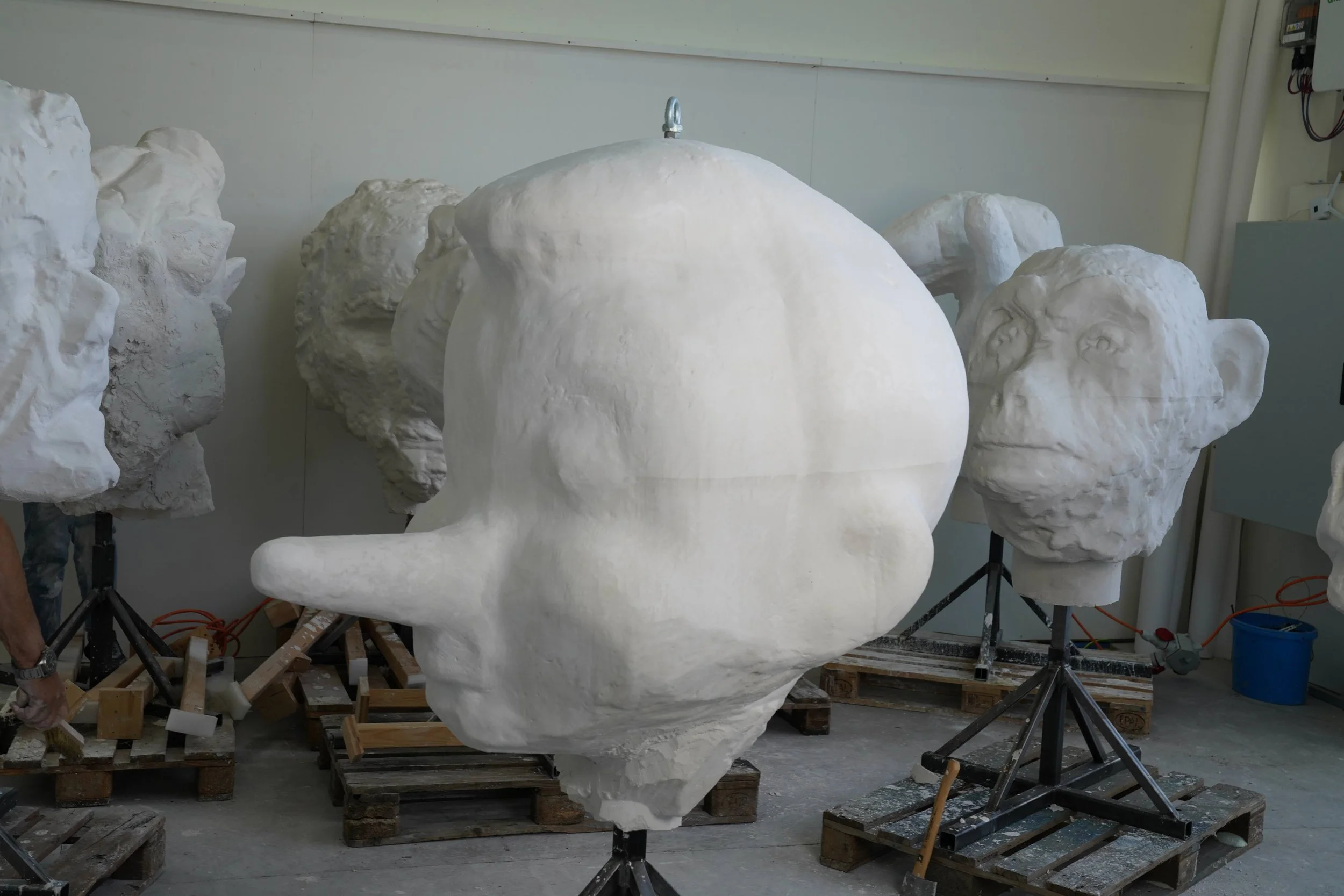Pop Antiquity by Vincenzo Trione
Jim Dine: Elysian Fields
Napoli, Castel Nuovo
10 October 2025- 10 February 2026
Curated by Vincenzo Trione
Pop Antiquity: text by Vincenzo Trione
Photography: Daniel Clarke
Palatine Chapel
Elysian Fields, 2022-2025, 23 Plaster Heads, Dimensions variable
The Gate Where Venus Sleeps, 2025. Bronze and Steel, 255 x 176 x 470 cm
7 Archeological elements
Photos: Daniel Clarke
Pop Antiquity
Vincenzo Trione
(The following text has been translated from Italian.)
First, there is the disorder of the world. It resembles a sprawling notebook or a surrealist text, where the most diverse elements appear — absurdity, good, evil, courage, filth, and unimaginable mutations of reality. It is an unstable, precarious, fluid constellation without fixed points, crisscrossed by unexplored paths and empty passages. A surface on which every element slips away — like a chalkboard where an invisible hand continuously erases different events. It calls to mind "that bird which is everywhere and nowhere," mentioned by Octavio Paz in his 1990 Nobel Prize speech: “We try to catch it alive, but it opens its wings and vanishes, transformed into a handful of syllables,” the great writer said.
Through his wanderings and experiments, Jim Dine has remained faithful to the idea of art as a privileged tool to interrogate the present and grasp its essence — inclined to lean into the artificial nature of things. That is, what Roland Barthes called “absolute sociality,” the “herd-like.”
An accidental archaeologist of the contemporary, Dine captures mute episodes of a world speeding along the rails of time: garments, bathrobes, ties, shoes, suspenders, shower tubes, hammers, saws, shovels, axes, palettes, brushes, cans, and chisels. He adopts these anonymous, used, lived-in, dirty, secretly picturesque fragments, treating them like already-spoken words, ready to be inserted into new discourses, reactivating their unsettling symbols and meanings.
At first, he de-functionalizes these relics, extracting them from their original contexts. He surrounds them. He approaches them. Then, he steps back — only to return again. He reveals them as primary traces, capable of triggering a chain of reactions and accidents. He offers them to us as stereotypes: in their solitary, stark, brutal frontality. He displays them with bold individuality. Finally, he suspends them in silence and void, freezing them in a near-metaphysical stillness — perhaps recalling Ivan Puni’s Suprematist assemblages or the refined zoom-ins of Domenico Gnoli.
Sometimes, this master born in Cincinnati in 1935 simply presents objects as is, pushing communication to a zero degree. Other times, he places these fossils next to photographic representations. More often, he transfigures and alters their identities, embedding them within the backgrounds of his canvases — rendered with techniques rooted in Art Informel.
These are various ways to try to preserve scraps of life, safeguarding them — as Alberto Boatto wrote — in that “singular universe called art, or even spectacle, fiction.”
There are many differences between Dine’s poetics and those of Pop Art, which he initially approached. Aligned more with New Dada (like Johns and Rauschenberg), Dine paints works that are less sterile, less impersonal, and less “assertive” than those by Warhol or Lichtenstein. His work expresses deep discomfort and a sincere taste for imprecision and imperfection. His ambition is to stage instability, fragility, and restlessness — combining the objectivity of “ready-mades” with the subjectivity of painterly interventions.
In a long conversation during his major 2020 retrospective at the Palazzo delle Esposizioni in Rome, Dine told me:
“Pop Art is just one facet of my work. I don’t exclusively use popular images, technically reproduced. Of course, they interest me — because they’re part of my visual landscape. But what truly interests me are images tied to my existence. [...] Pop artists tend to offer answers, solutions. I, on the other hand, like to paint by focusing on the problem of making a painting, of seeing: I want to make the viewer more aware of the visible, without offering easy answers on a silver platter. You know, any successful work of art is, in itself, a critical commentary on its own content. [...] I don’t chase imperfection, but I’m inclined to accept that if you’re human, nothing is perfect. What truly excites me is making paintings in my studio: the act itself — choosing colors, working the palette. [...] The romance of ‘handmade’ has always stayed with me. I’m proud to be a laborer in the field of art. [...] I believe great beauty can emerge from clashes and accidental conflicts. This is a beauty that helps us better know our hidden selves. [...] My subconscious and my inner and outer life are the material I start from and constantly interrogate.”
— V. Trione, “My artworks with tubes and hammers,” in “la Lettura – Corriere della Sera”, January 26, 2020.
The fascination with impurity is central to the works exhibited at Dine’s solo show in Naples’ Castel Nuovo — spread across the Palatine Chapel, the Chapel of the Souls of Purgatory, and the Armory Hall. A labyrinthine path, based on the artifice of crossover: Dine’s dramaturgies enter into dialogue with ancient relics and Renaissance sculptures from the castle’s collection (including Madonna and Child sculptures by Francesco Laurana and Domenico Gagini).
Behind this curatorial gesture lies a necessity. It’s as if — having entered the realm of Homer’s “noble old age” — Dine feels compelled to merge realism and archaeology. On one hand, recalling New Dada and Pop Art achievements, he seeks strong recognizability. On the other, he expresses a desire common to many American artists: seduction by antiquity seen as a far-off fable, unmoored from specific history, ready to be endlessly reshaped.
Dine embarks on a journey back toward classicism — not as a static gallery of eternal figures or motifs to be passively repeated, but as an arsenal of enduring values to inhabit, betray, or profane. Not a rediscovery of appearances, but a radical experience that might change us. Not a dead inheritance, but a foundational, decisive, necessary patrimony — ours, and yet intimately foreign and surprising. Not a fixed, untouchable place or destination, but a reservoir for the future, a trove to be explored and manipulated.
Here lies the essence of humanity. Especially in times of crisis and unease, the works of the “fathers” offer a reservoir of awareness. They help fill a chasm whose bottom we struggle to see. These works are not our contemporaries — we must become contemporaries to them.
Unlike modernity, classicism encompasses both past and present. It belongs to us and remains distant; it exists, but must be conquered; it holds knowledge and is open to hybridization.
Toward this imaginary Eden, Dine is driven by a vague passion. He’s especially fascinated by what’s missing — the fragments, the plaster casts, the mysterious voids of Greek statuary. Enchanted by absences, he collects survivals, severed from any cultural context. He listens to their voices. He disassembles and reassembles them. He doesn’t seek a fixed or immutable image of the past. He retrieves antiquity in a rhapsodic way.
This idea gives rise to his recent sculptures, which resemble ruins. Perhaps fished from ocean depths — here are headless deities (e.g., Venus and Neptune, 2023), their original beauty obscured by layers of accretion. Here too are physiognomic studies with imperfect autobiographical references (Elysian Fields, 2022–2025).
Extracted from some mysterious underground, these iconographies are at once monumental and fragile. They signal the end of a world while preserving burning traces of it. As powerful metaphoric epitomes — entangling death and rebirth — they appear as creations consumed by history and nature. On the threshold between not yet and no longer, resistant to formal satisfaction, reluctant to geometry, they mimic the action of time — “the great sculptor” (as Marguerite Yourcenar called it). Finally, the handwritten texts in a small Castel Nuovo room appear as nervous graffiti etched in a crypt.
As he moves forward, Dine returns to his beginnings. Consider The Gate Where Venus Sleeps (2025), a bronze and steel door installed at the apse of the Palatine Chapel. It’s a “junk sculpture” filled with echoes of The House — an installation he created in 1960 in the basement of Judson Memorial Church in NYC: a room crowded with springs, broken chairs, rags, and shattered glass.
Back in our 2020 conversation, I asked what remains of the Jim Dine from the age of the American Dream.
“I’ve been an artist for over seventy years. My work has changed over time. That’s inevitable. After I’ve done something, I move on to the next. These transitions are simply different facets of my human and intellectual identity.”
—
Vincenzo Trione
Advisor to the Mayor of Naples for Contemporary Art and Museums
Curator of the Napoli Contemporanea program
To read the entire exhibition text, download the pdf below.




